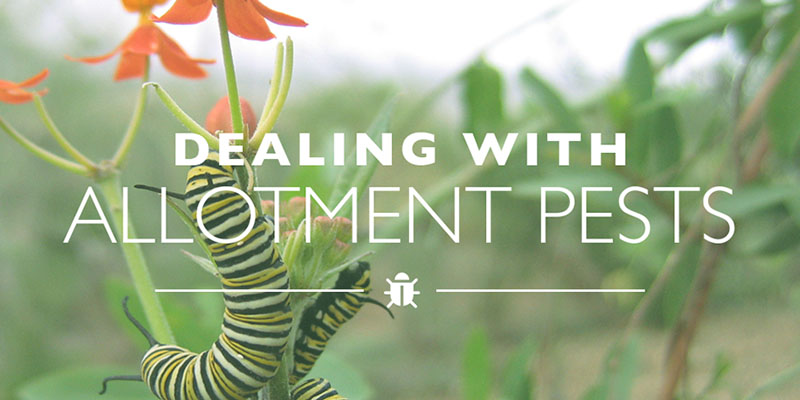Dealing With Allotment Pests

With summer in full swing, it’s the best time to be soaking up the sun outdoors and keeping busy. For increasing numbers of people across the country, maintaining an allotment has become a fantastic pastime, and it’s not difficult to see how allotment owners everywhere get great satisfaction from seeing their hard work getting rewarded with delicious fresh food.
However, there’s nothing more disheartening than when gardeners start noticing the damage dealt by invasions of nasty pests. Worse still, as soon as these blighters get a taste of your lovingly grown fruit and veg, they’re likely to be back year in year out. That’s why it’s important to recognise the signs and take measures as soon as possible.
Here at HIPPO, we’re passionate about allotments, so we thought we’d offer up a few tips on recognising pests and how to deal with them.
COMMON PESTS AND WHAT CAN BE DONE
APHIDS (GREENFLY AND BLACKFLY)
Anyone who has tended an allotment for any amount of time has had to deal with aphids at some point. They are the most common and consistently troublesome pests that attack all manner of different plants, and they exist in huge numbers. The tell-tale signs of aphids are leaves covered in what looks like a thick layer of soot, as well as curled leaves and distorted, twisted shoots.

Because these pests reproduce so rapidly (towards the end of the summer), it’s a great idea to deal with them as soon as possible. For a short term solution, you can wipe them off of leaves and pick out any infected shoots, however, the absolute best way to deal with them is to get rid of their natural ally – ants. Aphids produce a honeydew like excretion that ants absolutely love, and the ants swarm them which then protects the aphids from predators.
ANTS
Ants will make matters worse when trying to get rid of aphids, so it’s best to get rid of them first. Ants build elaborate nests in and around plots, which can also damage the roots of plants, which can kill them. They also tend to nibble away at freshly sown seeds, and have been known to eat ripening fruit as well.

Depending on the severity of the ant infestation, you can rely on different ways to get rid of them. Some folks swear by spreading ant powder on visible nests, whilst, another option is to purchase a specially made sticky-tape material that you can use to line your plot. This will stop the ants from getting to the aphids and will eventually thin their numbers.
CATERPILLARS
Caterpillars are a nuisance for growers because they feed on the leaves and foliage of plants. If they aren’t dealt with, they will likely ruin your entire crop. If you can’t see them directly, you can tell that they’re about if you start noticing holes in leaves. It’s important to regularly flip leaves over to get a look underneath, especially if you see white butterflies hovering over your cabbage.

Short of simply removing them as soon as you notice them, you can deal with caterpillar attacks by covering brassicas with a fine net as soon as you plant them.
CABBAGE ROOT FLY
These white larvae will attack the roots of brassica plants such as swede, turnip, cabbage and radishes. You’ll know that you have them if your crops turn a bluish colour and quickly die. The best way to deal with them is to just remove any plants that you suspect as being infected as soon as possible, or you could also trying spraying your plot with a nematode based insecticide.
CARROT FLY
Despite the name, these pests will also attack parsnips, seedlings and most root vegetables. Keep an eye out for maggots that may appear around the roots of these veg, and also a clear sign of infestation is that leaves will turn a reddish colour before eventually turning yellow.

Unfortunately there’s not a great deal you can do about them, however, if you grow onions and chives as close as possible to them, it’s said that they will act as a natural deterrent.
WOODLICE
Woodlice are actually quite harmless as they are not rampant eaters, however, they will nibble on stem leaves and roots, so it’s only if they are in large numbers they will start to cause a problem.

The best way to keep their numbers down is to simply keep things tidy. Keep your plot free of dead leaves, and seeing as they like dark and damp conditions, clear up anything not being using that they could use as shelter such as empty pots (and also use as little wood in your allotment as possible!).
SLUGS AND SNAILS
Ask anybody who grows plants or vegetables which pest poses the biggest threat to their hard work, and chances are (in fact, we guarantee) they’ll say slugs and snails. They will eat absolutely everything, seemingly overnight, leaving many growers simply standing back, scratching their heads and wondering where it all went wrong.
First things first, it’s a good idea to clear away any places where snails and slugs could hide during the day. Weedy areas, stones, wooden boards and ground covering ivy provide such shelter, and need to be removed as soon as possible. It’s said that peppering your plot with orange or grapefruit slices are a good organic method to try and deter them, as well as planting strongly scented plants such as lavender, rosemary and sage.
Of course, frustration may eventually kick in, and if you can’t find something organic that works, you could always go with a liberal spattering of slug pellets to attempt to kill them off. But there is another method that actually works with any kind of pests, and is a fantastic way to promote a healthy plot, and that is to encourage natural predators who will do all the hard work for you.
ENCOURAGING PREDATORS
One of the best methods of pest control is to create an environment that encourages natural predators. For example, centipedes will eat slugs and snails, and beetles will also go for slugs, as well as larvae and root aphids. Hoverflies, dragonflies and ladybirds love to eat aphids, mites and caterpillars, as do earwigs.
To get these creatures close to your allotment (and this is tricky depending on the size of your plot), you best bet is to dig a pond. It doesn’t have to be that big, just a fairly sizeable body of water will be enough to attract all these other insects and animals that will work tirelessly to get rid of unwanted pests. A pond will also attract frogs, newts and toads, which love to eat slugs.
Of course, it’s also a good idea to attract birds, but just pick the time of year as you don’t want them eating freshly sown seed as well!
HIPPO wishes you the best of luck with your allotment, with a bit of graft (and the right research) you’ll be amazed at the great results that you can start to enjoy in no time. Pests will do all they can to ruin your good time, but we hope these pointers will at least give you a fighting chance. Do you have ideas of your own on how to best deal with pesky pests? Send us a Tweet @HIPPOBAG with your own tips/allotment horror stories!

